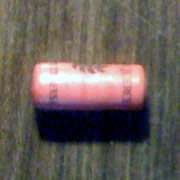Today's Sponsor• A message from WineLibrary.com
In This Issue• When cork alternatives go bad |
When cork alternatives go bad
 |
All of this activity can be traced back to a simple reality: While natural cork has been in general use as a wine stopper for more than 200 years, and a sound cork boasts certain natural advantages for wine cellaring, a small but non-trivial percentage of natural corks can ruin wine by tainting it with a chemical reaction between the wine and a natural fungus that occurs in cork.
Most of the alternative-closure activity has focused on two formats: The screw cap, particularly a heavy-duty brand called Stelvin; and synthetic stoppers that resemble corks in shape and size but are made of plastic.
Screw caps, initially abhorred because they evoked the cheap, rotgut wines that had long been packaged with a lightweight, simple version, have been gaining ground strongly in recent years. Particularly Down Under, it is becoming hard to find a white wine with any other closure, and the Stelvin is making strong inroads among reds.
Even in the more wine-conservative U.S. and Europe, screwcaps are becoming more and more common - and wine-savvy consumers are learning to embrace them, especially as lingering concerns about long-term aging begin to fade and producers master minor alterations in the bottling process.
But the story on synthetics, sadly, doesn't have such a happy ending. Quickly embraced by many in the industry because they're shaped like corks and can be made to look a bit like corks (albeit sometimes in wild and wacky colors), and can usually be inserted by existing bottling lines and removed - sometimes with difficulty - with a standard corkscrew.
Unfortunately, while solving the problem of cork taint, synthetics soon showed problems all their own. Despite engineering efforts to fashion them with physical characteristics as close to natural cork as possible, growing experience suggests that they're not suitable for wines destined for anything more than short-term drinking.
In my experience, wines closed with either type of synthetic - solid plastic plug or two-component type with slick outer sleeve and foamy interior - are risky investments for keeping more than a year or two. It would take all my fingers and toes and more to count the synthetic-stoppered wines that I've found "tired" and marginally oxidized only three or four years after the vintage.
The latest offender, opened just the other night, was an Italian red from from Basilicata, the "instep" of the Italian "boot." I had tasted Tenuta le Querce 2000 "Il Viola" Aglianico del Vulture twice before, on April 18, 2004 and again on May 7, 2005 (at which point its retail price had jumped up three bucks to $18.99). Both times the wine showed lots of ripe dark fruit - plums, blackberries and blueberries - with licorice and oak and so much tannin that it clearly needed cellar time.
Fair enough.
I put away one more bottle, forgot it for a few years, until the other day, when I was rooting around in the same dusty corner that revealed the 1999 Julienas Cru Beaujolais featured in Monday's edition, I found the last bottle.
Out came the red plastic cork and ... meh. The tannins are still going strong, but the fruit is gone entirely, replaced by an odd aroma that smelled like mud puddles in red clay to me. My wife thought it smelled like plastic and spit it out, fearing that some petrochemical gunk had leached into the wine. Note well that I don't think this is likely. But the wine was dead on arrival, and I'm satisfied that the synthetic plug is to blame.
It's too bad when a new technology intended to solve a problem proves to have new problems of its own, but that, I suppose, is the price of progress. Bring on the screw cap, as far as I'm concerned!
Today's Sponsor
A message from WineLibrary.com
Are you on Wine Library's e-mail service? If not, you are missing out on the hottest new 90+ pointers at rock bottom prices! Log on to winelibrary.com to sign up for our daily offering or weekly recap today!
One highly rated wine you may have missed: Don Nicanor Malbec 2005, a dark and sultry Argentinean red. Rated 91 points in Wine & Spirits, it's just $12.99 a bottle on sale at Wine Library, a brilliant QPR option to open any night! Log on to place your order today ... Click here for details!
You may have seen us featured in GQ magazine, The Wall Street Journal, New Jersey Monthly and elsewhere. Wine Library features a huge collection of top wines from around the world, great gifts and accessories, a daily video blog (Wine Library TV), a wide selection of futures, and much, much more!
Bottom line, we offer the lowest prices, the largest selection, lightning fast shipments and the greatest customer service in the industry! Winelibrary.com is your one-stop shop for everything wine... so what are you waiting for? Log on to winelibrary.com today!
Talk About Wine Online
If you have questions, comments or ideas to share about today's article
or wine in general, you're always welcome to drop by our online
WineLovers Discussion Group. This link will take you to the forum home page, where you can read discussions in all the forum sections:
http://www.wineloverspage.com/forum/village
Everyone is free to browse. If you'd like to post a comment, question or reply, you must register, but registration is free and easy. Do take care to register using your real name, or as a minimum, your real first name and last initial. Anonymous registrations are quietly discarded.
To contact me by E-mail, write wine@wineloverspage.com. I'll respond personally to the extent that time and volume permit.
PRINT OUT TODAY'S ARTICLE
Here's a simply formatted copy of today's Wine Advisor, designed to be printed out for your scrapbook or file or downloaded to your PDA or other wireless device.
http://www.wineloverspage.com/wineadvisor2/2008/10/when_cork_alternatives_go_bad-print.html





